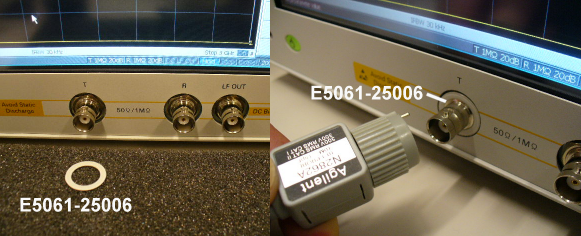
Do not apply the DC voltage or current to the test port except the following conditions.
Port 1 and 2: AC Coupling
Port R and T: 1 MΩ Input impedance
Applying DC voltage or current may lead to device failure. In particular, the capacitor might remain charged. Connect the measurement sample (DUT) to the test port (or the test fixture, cables, etc. connected to the test port) after the analyzer has been completely discharged.
The maximum DC limit of Port1, Port 2, R and T ports is 7V for 50 Ω input impedance, 42V for 1 MΩ input impedance.
When the exceeded DC is detected, the Overload Detection function is activated to protect the analyzer input circuit.
When you use the probe which has a pin on the connector, place the plastic ring (E5061-25006) on the ports T and R in order to avoid connector from damage. E5061-25006 are furnished with the E5061B option 3L5/3L4/3L3 at shipment.

Applying exceeded RF power may lead to device failure. In particular, an external Signal Generator is used.
When the exceeded RF is detected, the Overload Detection function is activated to protect the analyzer input circuit and port impedance becomes short with turning off the internal source. Since the E5061B does not turn off the external Signal Generator input, the RF power from the Signal Generator reflects back to the measurement sample (DUT).